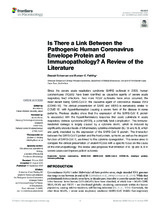| dc.contributor.author | Fielding, Burtram Clinton | |
| dc.contributor.author | Schoeman, Dewald | |
| dc.date.accessioned | 2020-12-15T10:37:25Z | |
| dc.date.available | 2020-12-15T10:37:25Z | |
| dc.date.issued | 2020 | |
| dc.identifier.citation | Fielding, B. C., & Schoeman, D. (2020). Is there a link between the pathogenic human Coronavirus envelope protein and immunopathology? A review of the literature. Frontiers in Microbiology ,11,2086 | en_US |
| dc.identifier.issn | 1664-302X | |
| dc.identifier.uri | http://hdl.handle.net/10566/5520 | |
| dc.description.abstract | Since the severe acute respiratory syndrome (SARS) outbreak in 2003, human
coronaviruses (hCoVs) have been identified as causative agents of severe acute
respiratory tract infections. Two more hCoV outbreaks have since occurred, the
most recent being SARS-CoV-2, the causative agent of coronavirus disease 2019
(COVID-19). The clinical presentation of SARS and MERS is remarkably similar to
COVID-19, with hyperinflammation causing a severe form of the disease in some
patients. Previous studies show that the expression of the SARS-CoV E protein
is associated with the hyperinflammatory response that could culminate in acute
respiratory distress syndrome (ARDS), a potentially fatal complication. This immunemediated damage is largely caused by a cytokine storm, which is induced by
significantly elevated levels of inflammatory cytokines interleukin (IL)-1β and IL-6, which
are partly mediated by the expression of the SARS-CoV E protein. | en_US |
| dc.language.iso | en | en_US |
| dc.publisher | Frontiers Media S.A. | en_US |
| dc.subject | Human coronavirus | en_US |
| dc.subject | SARS-CoV | en_US |
| dc.subject | COVID-19 | en_US |
| dc.subject | Envelope protein | en_US |
| dc.subject | Immunopathology | en_US |
| dc.title | Is there a link between the pathogenic human Coronavirus envelope protein and immunopathology? A review of the literature | en_US |
| dc.type | Article | en_US |

